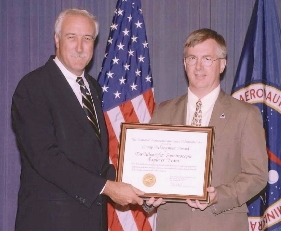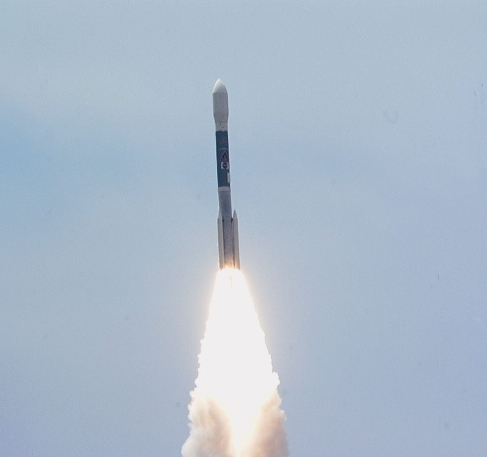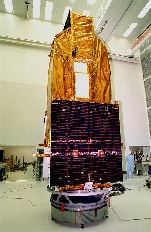

Mission Status Report #75 Star Date: June 24, 2004
FUSE Completes Five Years in Orbit!Caption: The FUSE satellite aboard its Delta-II rocket disappears into the hazy blue sky above Cape Canaveral Florida, June 24, 1999. Since launch, FUSE has orbited earth more than 26,000 times and traveled over 700 million miles (1.1 billion kilometers). (Photo courtesy NASA and the FUSE project.)
It has been five years since the FUSE satellite was launched into its roughly 500 mile circular orbit above the earth. The science instrument, a far-ultraviolet spectrograph, continues to operate extremely well, and its overall sensitivity has diminished only slightly (about 20% on average) over the lifetime of the mission. (Given that some pre-launch estimates were that it would lose 20% sensitivity per year, this is an outstanding result.) Unlike the Hubble Space Telescope, FUSE is not "servicable." We can't send astronauts (or robots) up to the telescope to make changes or updates to it. But that doesn't mean that ground controllers are helpless in the face of problems. Many of you regular readers followed our earlier rescue of the science mission following problems with our reaction wheels back in late 2001. (See Mission Report #52 and following reports.) That rescue involved both changes to flight software and also using different elements of the satellite hardware (Magnetic Torquer Bars) in new and clever ways. After fixing that problem, FUSE scientists and engineers turned their attention toward fixing another area of concern BEFORE it became a problem. The potential problem was the loss of one or more ring-laser gyroscopes that are part of the satellite's Attitude Control System. Almost every satellite that requires stable pointing has gyros that provide information on pointing and drift rates to the control software. FUSE's gyros started showing some evidence of "aging" very early in the mission, and this had been a concern for a long while.
In five years, the FUSE satellite has overcome these problems to become a true workhorse for the astronomical community at large. Over 600 astronomers from 20 countries around the world have requested observations with FUSE, many of them multiple times. Over 700 articles including FUSE results have been published (227 in professional refereed journals) and the number is climbing each month. In total, FUSE has observed nearly 2200 unique astronomical objects for nearly 47 MILLION seconds of observing time! (Visit the FUSE by the Numbers page for details.) On behalf of the astronomical community, I would personally like to congratulate and thank the 600+ people who have worked on the development and operations phases of FUSE for a job well done.

Caption: On behalf of the FUSE project, Bill Blair accepts the NASA Group Achievement Award, given in 2002, from NASA Administrator Sean O'Keefe. (Photo courtesy NASA and the FUSE project.) Even as we look BACK and enjoy the accomplishments of this remarkable satellite, we look FORWARD to the future! FUSE is still a vibrant satellite-observatory, which in many ways is working better than ever. Demand is high for continued observations. About 150 scientists from around the globe will meet in Victoria during the first week of August 2004 to present new results based on FUSE data and exchange ideas about how to use the satellite in new and even more innovative ways. NASA is about to release the Call for a new round of proposals, Cycle 6. Details are posted at the FUSE Guest Investigator Support Site. [ link no longer active] The deadline for receipt of proposals is September 17, 2004. Here's hoping for at least several more years of wonderful data gathering with the FUSE satellite!
Reported by: Bill Blair, FUSE Chief of Observatory Operations
|

